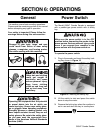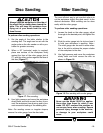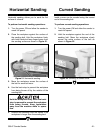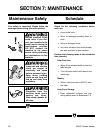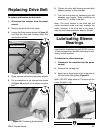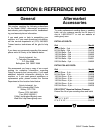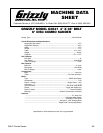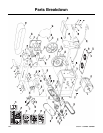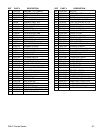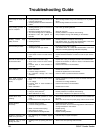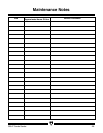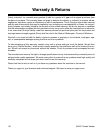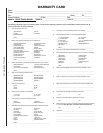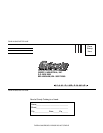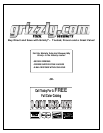
-28-
G0547 Combo Sander
Troubleshooting Guide
TROUBLE
Grains easily rub off the belt
or disc.
Deep sanding grooves or
scars in workpiece.
Sanding surface clogs
quickly or burns.
Glazed sanding surfaces.
Motor will not start.
Motor will not start; fuses or
circuit breakers blow.
Motor overheats.
Motor stalls (resulting in
blown fuses or tripped
circuit).
Burn marks on workpiece.
Machine slows when
operating.
Machine vibrates
excessively.
Workpiece frequently gets
pulled out of your hand.
Workpiece lifts up from
sanding disc table.
CAUSE
1. Sanding belt/disc has been stored in an
incorrect environment.
2. Sanding belt/disc has been smashed or
folded.
1. Sanding belt/disc grit is too coarse for
the desired finish.
2. Workpiece sanded across the grain.
3. Too much sanding force on workpiece.
4. Workpiece held still against the
belt/disc.
1. Too much pressure against belt/disc.
2. Sanding softwood.
1. Sanding wet stock.
2. Sanding stock with high residue.
1. Low voltage.
2. Open circuit in motor or loose connec-
tions.
1. Short circuit in line cord or plug.
2. Short circuit in motor or loose connec-
tions.
3. Incorrect fuses or circuit breakers in
power line.
1. Motor overloaded.
2. Incorrect usage of machine.
3. Air circulation through the motor
restricted.
1. Short circuit in motor or loose connec-
tions.
2. Low voltage.
3. Incorrect fuses or circuit breakers in
power line.
4. Motor overloaded.
1. Using too fine of sanding grit.
2. Using too much pressure.
3. Work held still for too long.
1. Applying too much pressure to work-
piece.
2. Undersized circuit or using ext cord.
1. Incorrect motor mounting.
2. Incorrect sanding belt tension.
3. Weak or broken tension spring.
4. Idler roller is too loose.
5. Broken/defective sanding belt/disc.
1. Not supporting the workpiece against
the stop.
1. Sanding on the up spinning side of the
disc
CORRECTION
1. Store sanding belt/disc away from extremely hot or dry temper-
atures.
2. Store sanding belt/disc flat not bent or folded.
1. Use a finer grit sanding belt/disc.
2. Sand with the grain.
3. Reduce pressure on workpiece while sanding.
4. Keep workpiece moving while sanding on the belt/disc.
1. Reduce pressure on workpiece while sanding.
2. Use different stock. Or, accept the characteristics of the stock
and plan on cleaning/replacing belts frequently.
1. Dry stock properly before sanding.
2. Use different stock. Or, accept the characteristics of the stock
and plan on cleaning/replacing belts/discs frequently.
1. Check power supply for proper voltage.
2. Inspect all lead connections on motor for loose or open connec-
tions.
1. Inspect cord or plug for damaged insulation and shorted wires.
2. Inspect all connections on motor for loose or shorted terminals
or worn insulation.
3. Install correct fuses or circuit breakers.
1. Reduce load on motor.
2. Reduce the applied load on the machine.
3. Clean out motor to provide normal air circulation.
1. Inspect connections on motor for loose or shorted terminals or
worn insulation.
2 Correct the low voltage conditions.
3. Install correct fuses or circuit breakers.
4. Reduce load on motor.
1. Use a coarser grit sanding belt/disc.
2. Reduce pressure on workpiece while sanding.
3. Do not keep workpiece in one place for too long.
1. Sand with less pressure—let the movement of the belt/disc do
the work.
2. Make sure circuit wires are proper gauge & don’t use ext cords!
1. Check/adjust motor mounting.
2. Make sure tension lever is in tensioning position. Follow belt ten-
sioning instructions in this manual.
3. Replace spring.
4. Adjust idler roller.
5. Replace sanding belt/disc.
1. Use back stop to support workpiece.
1. Sand on the down spinning side of the disc.



